The ASRock X370 Gaming-ITX/ac Motherboard Review
by Gavin Bonshor on April 18, 2018 8:00 AM EST- Posted in
- Motherboards
- Gaming
- AMD
- ASRock
- Mini ITX
- ITX
- AM4
- Ryzen
- X370
- X370 Gaming-ITX/ac
BIOS
ASRock is using its Fatal1ty gaming themed BIOS (version P4.50) which fits in with the same red and black theme as the board. While the BIOS doesn’t have a basic or an advanced mode, everything can be found within one consistent and well laid out UEFI BIOS. Providing information about the different features and functions is a description panel located at the right-hand side, which includes a QR code for further information. The text is white in color and when each setting option, a red highlight is present to signify what’s currently selected.
Upon entering the BIOS, which can be done so by pressing either the F2 or Del keys on POST, the initial splash screen displays key details including the current BIOS version, the motherboard model, the installed processor as well as the speed and current microcode of the CPU. Also displayed is the total amount of installed memory including which memory mode the memoryis operating in: single or dual channel.
The next section across is the OC Tweaker which contains the overclocking options for frequency and voltages. To manually overclock the frequency, changing the CPU Frequency and Voltage Change option from automatic to manual opens up changeable CPU Frequency and CPU voltage options. Aside from this, further below the user can enable the X.M.P 2.0 profile on the memory, as well as offset adjustments on the CPU Vcore and SoC (VDDCR). Further below these options, the option to set memory voltage.
Note: While using this board with a Ryzen 2000 series APU, options to change GFX frequency were not present with the latest BIOS available (version P4.50), although there was an offset to add additional voltage to the SoC. You can however overclock the Vega cores on the iGPU with the AMD Ryzen Master overclocking utility.
The ASRock X370 Gaming-ITX/ac does not feature built-in LEDs, but a single RGB LED header is featured on this board and can be controlled without installing the ASRock software. Under the Tools sub-menu, the single LED channel offers different LED effects including the likes of static, breathing, cycling and even random color flashing.
With the ASRock FAN-Tastic tuning utility integrated into the UEFI BIOS, users can simultaneously customize the fan-temperature respone all of the headers together or individually. There is a manual adjustment option or the included pre-defined profiles such as silent, standard, performance or full speed can be used. The FANTuning function can automatically detect fan speeds when used which helps to optimize the right balance between temperatures and speed, which can help to reduce noise with fans operating in just DC mode. It is worth noting that the 4-pin CPU fan header is only enabled for PWM fans and does not support alternative options.
Just as was noted in the ASRock AB350 Gaming K4 review, ASRock could do more to augment the built-in RGB LED options for the included RGB header to make it easier to select the colors; the addition of a color wheel would be a much better alternative as opposed to defined set numeric values. The BIOS overall is very responsive, is simple to use and features everything (except sufficient iGPU frequency options for Ryzen 2000 series APUs).
Software
As with the rest of the ASRock Fatal1ty range of AM4 socketed motherboards, the software package on offer isn’t as comprehensive as the likes of MSI and ASUS in terms of sheer volume of applications, but what ASRock do offer is sufficient for a number of tasks. The key software on the disc includes the F-Stream overclocking utility, and the ASRock RGB LED software. We do recommended downloading the latest versions direct from the support section from the product page of ASRock website for an improved and better all-around experience.
Most of the following analysis in this section was taken from our ASRock B350 Gaming K4 motherboard review.
Probably the most notable of the supported software applications is the OEM Sound Blaster 3 utility from Creative. The software allows the use of functions such as SBX Surround, which is designed to increase the realistic nature of the audio played. It’s a pretty intuitive feature and aside from the ability to create your own custom sound profiles, they do include pre-sets for things like gaming, music, movies etc. Another smart feature is SBX smart volume which moderates the volume to avoid large spikes which can cause ear discomfort.
Another handy application for providing customizability is the ASRock RGB LED software. It does exactly what it says on the tin and allows the user to customize the single RGB LED strip implemented on the X370 Gaming-ITX/ac (non-addressable). Other than this, there are no other LEDs featured on the board.
While AMD does a fantastic piece of software for overclocking within the operating system (AMD Ryzen Master), ASRock, like most other vendors, has its own version. Options for fine tuning of voltages can be found here as well as increasing the CPU frequency on the fly. ASRock F-Stream is more suited towards overclockers who want to fine tune their overclocks within the operating system, and everything the software does can be done within the BIOS.



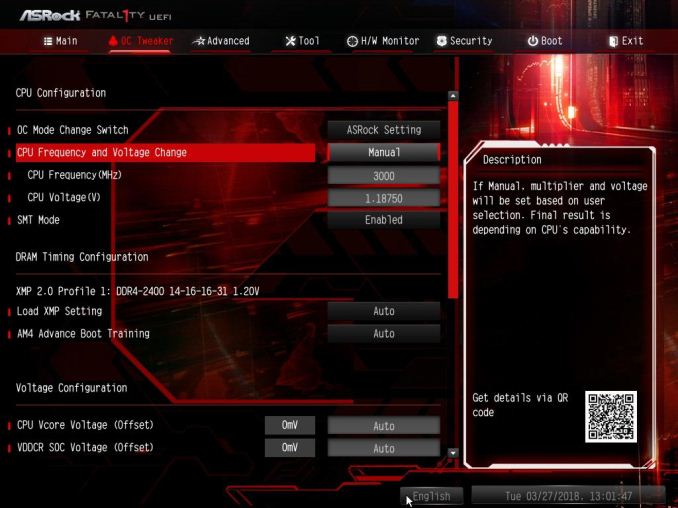
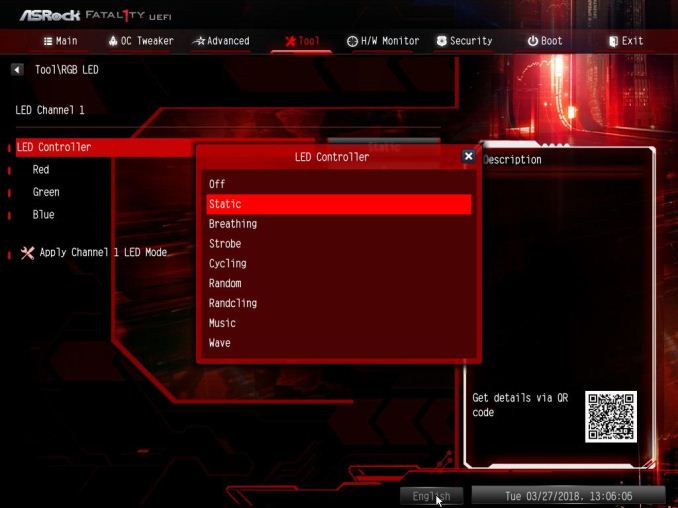
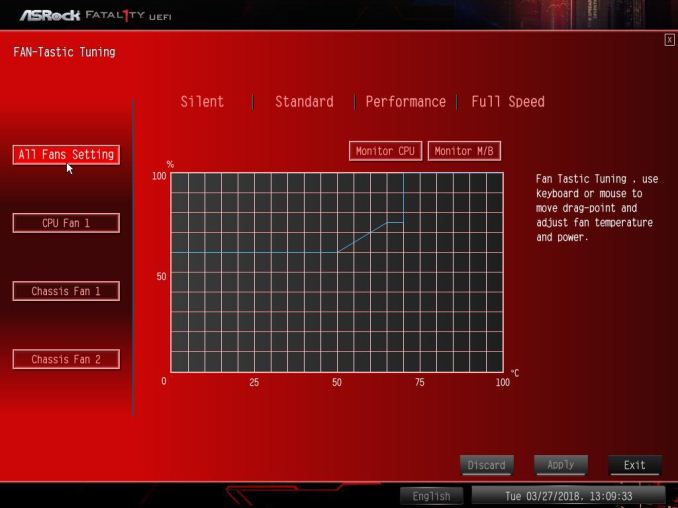
_thumb.jpg)
_thumb.jpg)
_thumb.jpg)
_thumb.jpg)
_thumb.jpg)
_thumb.jpg)
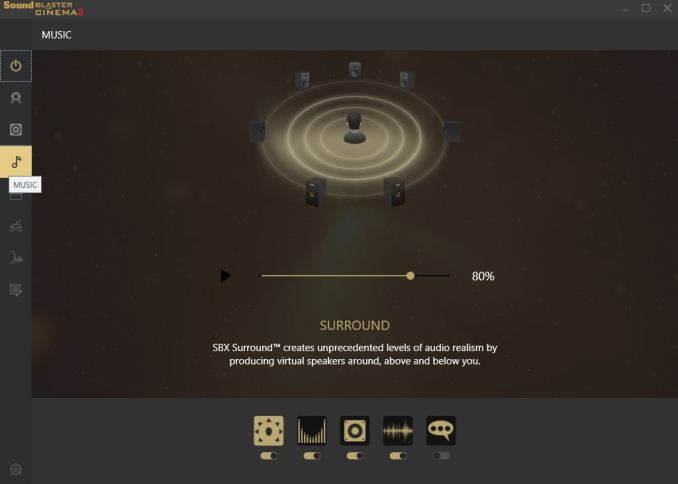
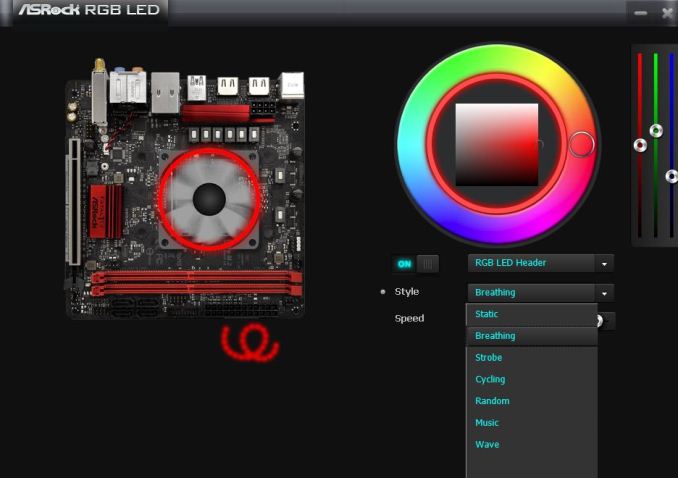
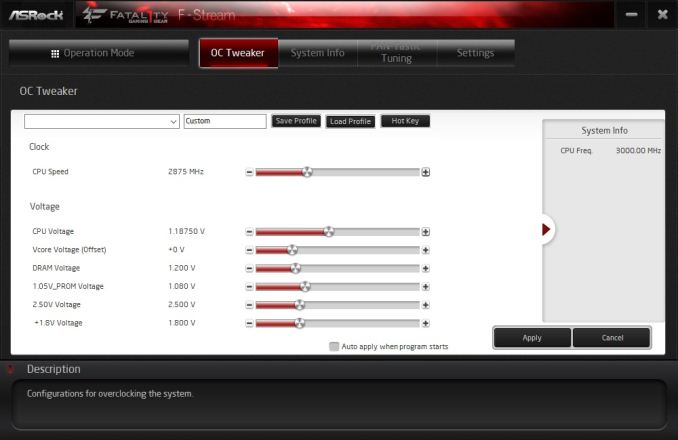
_thumb.jpg)
_thumb.jpg)
_thumb.jpg)
_thumb.jpg)
_thumb.jpg)
_thumb.jpg)








30 Comments
View All Comments
1_rick - Wednesday, April 18, 2018 - link
On the antenna? Yeah, I made a mistake on my previous post: the antenna wire pulled right out of the plug. Looks like it was only inserted or crimped in by pressure; no solder: the end of the wire is clean and not ragged. I tried pushing it back in but it didn't make a good enough connection; I never good good signal after that. (Oddly, even with both leads plugged in it got poor reception.)I'm using one of these now: https://www.frys.com/product/7411565. Keep meaning to buy a second, but the machine runs OK with just one.
Not sure what's going on with the ethernet port, if it died or if I killed it, although I don't know what I could've done to it. If the wifi didn't work I'd be more concerned.
My board couldn't run RAM at over 2133-2400 stably until the most recent BIOS updates; now it runs my 3000 ram at 2933 just fine.
Also these comments inspired me to try OC a bit more--currently I'm running at 4.0 with 1.39375. Games fine; haven't tried a stress test yet.
The_Assimilator - Thursday, April 19, 2018 - link
This board exposes 2x 480Mbps (USB 2.0), 2x 5Gbps (USB 3.1/3.1 gen 1), and 2x 10Gbps (USB 3.1 gen 2) USB ports on its IO. The X370GTN exposes 4x 5Gbps and 2x 10Gbps ports.jtd871 - Monday, April 30, 2018 - link
Check your eyes, sir. Neither this board nor the B350 version claim Gen 2 support. http://www.asrock.com/mb/AMD/Fatal1ty%20X370%20Gam... http://www.asrock.com/mb/AMD/Fatal1ty%20AB350%20Ga...Hifihedgehog - Wednesday, April 18, 2018 - link
Gavin, despite what manufacturers may say, HDMI 2.0 works on all 300-series motherboards as well. I thoroughly investigated and tested this with Raven Ridge. In fact, my family's current HTPC, with a Ryzen 5 2400G and ASRock AB350 Gaming-ITX/ac, works flawlessly at 4K@60Hz and 12-bit color. The so-called "specification" these motherboard manufacturers list is really regarding certification alone. The ports really are just straight traces to the processor's video outputs. See here for more details:smallformfactor (dot) net/forum/threads/raven-ridge-hdmi-2-0-compatibility-1st-gen-am4-motherboard-test-request-megathread.6709/
John_M - Saturday, April 28, 2018 - link
I couldn't see the point of paying extra for the X370 version of this ITX board when the B350 delivers exactly the same performance and functionality so I bought the latter. Apart from the chipset used the only difference I can find is the different WiFi card. Does anyone disagree?jtd871 - Monday, April 30, 2018 - link
That appears to be one of very few differences that I can spot between the official specs for each board. The X370 claims 2T/ 2R on the wifi. The other difference that I noticed was a claimed difference in watercooling support (see CPU section on the respective spec page of each board via AsRock.com). I second your recommendation to get the B350 board as it is significantly less expensive as of this post.John_M - Saturday, April 28, 2018 - link
What do you mean when you use the term "ambient cooling"? I Googled it and found that it refers to the building of datacentres in locations that are naturally cool so as to save costs on cooling. But what does it mean in the conetxt of this review?John_M - Saturday, April 28, 2018 - link
There are five 3.5mm audio jacks, not six.John_M - Saturday, April 28, 2018 - link
You can overclock the iGPU of a Raven Ridge APU in the BIOS, though it's hidden quite deep in the menus of the Advanced page.wswab - Wednesday, February 13, 2019 - link
HOW DO YOU SET THE (IT WAS ERP READY IN MY GIGABYTE BOARD ) OR WHERE IS SETTING TO STOP USB PORTS FROM STAYING POWERED ON AFTER SHUTDOWN !! LED,S STAY LIT !! HELP APPRECIATED ..